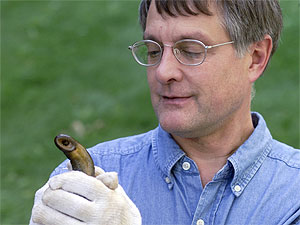|
Audio
Photos
Resources
|
Duluth, Minn. — The sea lamprey came into the Great Lakes through canals more than 100 years ago. They're parasites, attaching themselves to big fish and sucking the juices out. Each lamprey can kill 40 pounds of fish in its lifetime.
Wildlife managers use a chemical called TFM to keep the lamprey numbers down. They spread the lampricide in streams in the spring, to kill some of the young lamprey as they swim down into the lake.
University of Minnesota biologist Peter Sorensen says he and other scientists noticed that TFM kills not just the juveniles, but the larvae that live in the stream bed too. They also realized, after a stream is treated, very few adult lamprey come back to the stream to spawn, or lay new eggs.
"And this led to an observation decades ago -- which was key -- that adult lamprey must be selective in how they pick streams," Sorensen says. "They only pick a few, and if you remove the larvae they don't seem to go in there."
Scientists suspected the larvae might play a role in the spawning migration of adults. That might mean the larvae are putting out a pheromone that tells the adults it's a good place to spawn. Just one larva attracts a lot of adult lamprey, indicating the pheromone is very potent.
It was up to Jared Fine to determine what the chemical is. Fine is a doctoral student working with Peter Sorensen. For two years he sifted through the water in tanks holding lamprey larvae.
|
They are driven animals -- frankly, they're kind of on autopilot. And pheromones are what's driving that autopilot to a very large extent.
- Researcher Peter Sorensen
|
"Separating the different chemical compounds, testing them biologically, seeing which ones have activity, coming back to the active ones, further separating them, and just repeating this until you get down to the one or two or three compounds that have the activity," says Fine.
He narrowed it down to three compounds. He purified them and gave them to a colleague in the chemistry department, Thomas Hoye. Hoye created a synthetic version of the most potent pheromone.
Hoye says it should be possible to produce it on a large scale. And that means it could be used to treat the Great Lakes. The question is, how much would he need?
"You know, would it be a tank car load, would it be a football field, would it be a dump truck? It's none of those," says Hoye. "Would it be a barrel? No. Is it a bucketful? No. In fact, it's only about 500 grams -- that's just one pound -- would treat all that water for a month."
And that's all it would take, because the lamprey only spawn for a month. But the treatment would have to happen once a year. Peter Sorensen says when lamprey approach a stream to spawn, their clock is ticking. They have a powerful urge to lay eggs, and once they've done that, they die.
"They are driven animals -- frankly, they're kind of on autopilot," Sorensen says. "And pheromones are what's driving that autopilot to a very large extent. And now that we've got it, I think we can really powerfully use that to our advantage."
Sorensen says fisheries managers could use the pheromone to attract more lampreys to streams outfitted with traps.
"The key here is the fact that this pheromone is natural, safe, and should be very inexpensive to add," Sorensen says.
Fisheries managers around the Great Lakes have been hoping for a breakthrough like this.
Pheromones are routinely used to control insects. Now, the Environmental Protection Agency has granted the first-ever permit to experiment with a lamprey pheromone on the Trout River in Michigan.
Sorensen's research is published in the November issue of Nature Chemical Biology.






